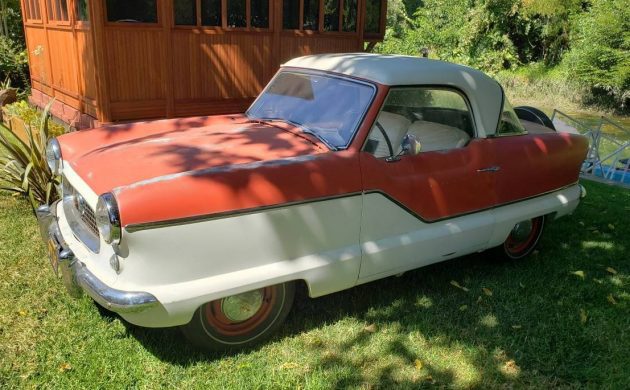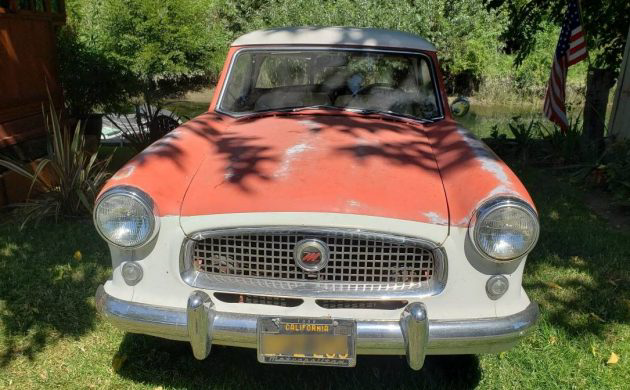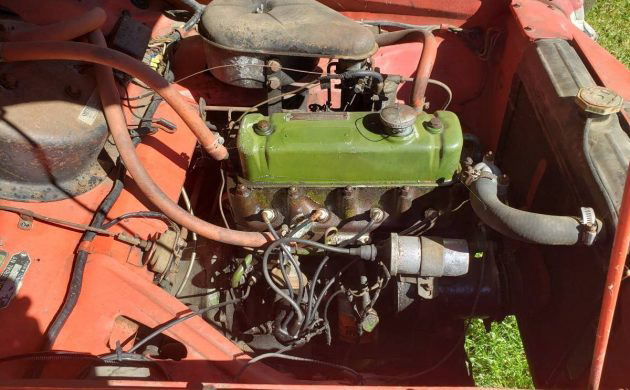If I were to say that the 1958 Metropolitan was advanced, you would probably fall off your chair laughing and wondering whether I had lost the plot. However, if I said that it was ahead of its time, that’s a different matter altogether. During the 1950s, when fuel was cheap and plentiful and when confidence was high, most potential buyers weren’t that interested in owning a small and fuel-efficient car. Today, any manufacturer who can produce such a vehicle will be fighting off those same people with a stick. The Metropolitan didn’t sell in the numbers its creators had hoped, but today, they are seen as a quirky classic. They aren’t a car that commands stratospheric prices, but they remain affordable for anyone considering dipping their toe into the water of classic car ownership. This little Metropolitan looks like one that would be easy to restore. It is complete and is said to run and drive well. If you want to find something to occupy your time during the upcoming colder months, maybe you’ve hit the jackpot. Located in Walnut Grove, California, you will find the Metropolitan listed for sale here on Craigslist. Projects don’t come much cheaper than this because handing the seller $5,500 will see this classic parked in your workshop. I have to say a big thank you to Barn Finder rex m for spotting this cool classic for us.
Nash never conceived the Metropolitan to serve as primary transport but to be used as a family’s second car for commuter or shopping duties. It is worth noting that its design had a few drawbacks that limited its appeal to potential buyers. The first was that lack of rear-seat space made this area only suitable for small children on shorter trips. Still, for running the children to school, it was not too bad. The second design flaw probably undermined its appeal more, and the company didn’t address this until January of 1959 when they added a decklid to the vehicle. Before then, luggage and groceries found their way into the trunk by folding down the back seat. That wasn’t particularly bad if the objects in question were few and small. However, fishing the weekly grocery shopping for an average family from the trunk was not something that the lady of the house would’ve found either pleasant or elegant. These factors probably sealed the Metropolitan’s fate in the market, with sales totals proving to be modest (to be kind). This little Metropolitan wears its original combination of Mardi Gras Red and Frost White, and the paint now shows some deterioration. It isn’t horrendous, but a repaint would significantly impact the vehicle’s presentation. Beyond that, the panels look pretty straight, and since it appears that the car has spent its life in California, its lack of rust problems is no surprise. The exterior trim looks to be in good order, as does the glass. So far, it appears that whipping this classic’s exterior into shape shouldn’t be complicated or expensive.
When we turn our attention to this classic’s interior, we find the area that has the potential to consume a few dollars. However, if a buyer approaches this with a bit of care, the interior can look as-new without the costs spiraling to the point where it isn’t financially viable. The painted surfaces are tired and would benefit from a refresh. That is the tip of the iceberg because the upholstery and trim have deteriorated badly. This interior needs nothing less than a complete restoration, and while this could be a problem, a sensible approach and some careful shopping mean that it need not be the case. It isn’t uncommon for trim kits for cars of this type and size to be expensive, but the Metropolitan is an exception to that rule. An online search allowed me to find a trim kit in black and white houndstooth cloth and vinyl for $1,230. The only thing that this kit lacked was a carpet set, but that added a further $240 to the total. That means that returning the interior to a factory-fresh state will cost under $1,500, which compares favorably with many classics on the market today.
When we delve below the surface of this Metropolitan, we find plenty of drivetrain components that originally called Britain home. The cars were built under contract in the UK by the Austin Motor Company in Longbridge. The bodies were shipped to Austin from Fisher & Ludlow, where Austin performed final assembly using their own drivetrain components. By the time our feature car rolled off the line, it came equipped with the 1,489cc B-series four-cylinder engine that pumped out 55hp. Those thoroughbreds found their way to the rear wheels via a 3-speed manual transmission. Performance figures were all that you might expect, although a meager weight of 2.050lbs meant that the 21.6-second ¼-mile ET was not too bad. However, it was its fuel efficiency that the company saw as its strongest point. In an era when many American cars struggled to improve on figures of 15mpg, the Metropolitan could easily break 30mpg. That was great in theory, but the harsh reality was that fuel prices were at rock bottom during this time, meaning that most buyers didn’t care whether their car sipped or gulped its fuel. The engine bay of our feature car presents well, and it seems that appearances aren’t deceptive. The owner says that it runs well, so it appears that the buyer won’t be outlaying money on mechanical work as part of this restoration.
The 1958 Metropolitan is not a car that commands high prices in today’s market. It isn’t hard to find tidy examples for under $15,000, although I have seen pristine cars nudge $20,000. Using that lower figure as our guide when determining this classic’s financial viability, the news is pretty positive if the buyer can undertake most of the work themselves. It seems that there are no rust repairs required, so the body only needs basic preparation and painting. The interior can be returned to a showroom fresh state for around $1,500, while the Metropolitan has no mechanical needs. Couple all of those attributes with the seller’s price, and this has the potential to easily remain a financially viable restoration project. When I early said that the Metropolitan was ahead of its time, I wasn’t joking. When it was new, it was on a hiding to nothing in a market where modest size and fuel efficiency counted for little. When you look at where the current market is headed, small, light, fuel-efficient cars have a ready market if they are built to a reasonable standard and are affordable. The “Metro” possessed all of those attributes, but the harsh reality is that it arrived on the market about sixty years too early. If a manufacturer started producing a car that embraces that spirit today, they couldn’t build them fast enough. So, technically advanced? No. Ahead of its time? Undoubtedly. That is why cars like this deserve to be saved.







When we say that gasoline prices in the late 1950’s were cheap, 19-25 cents a gallon, we have to remember that is not the same as what a quarter is worth today. $2.50 today is probably about what the worth of a quarter was back then. And back then I don’t think they added as many different taxes to the price of gasoline like they do today.
Back then, the only tax levied on a gallon of gas was 9 cents. That tax now is off the dark side of the moon.
Who cares if it has “black plates”…does it make the care more valuable?
I think not.
Every time a “black plate” car is on BaT, the comment section explodes with nerds coming out of the woodwork to out-educate each other on the nuances of these special plates. Meanwhile, the car gets sold out of state, the plates get tossed in a box in the garage and then promptly forgotten.
I dunno. Black plates in a shadow box with a photo of the car seems like a better plan.
Black Ca plates definetly add to the value showing it is an original Ca car. I think it would be a shame to paint this little beauty..I’d fix up the interior and enjoy it. The “only original once” phrase really does fit here and that “patina” is genuine. Be nice to add some performance parts to the motor which is easy as it shared the power plant with lots of BMC vehicles. If I had room I’d grab this one..
We have. 56 same colt that came from Cali. And absolutely love it
Posting deleted by author so maybe it’s sold.
eventho a Nash I think all Brit made (Fisher & Ludlow, birmingham?). Like em when they put in the trunk. Seen one of the 2 ever made waggys (on-line pic) and like it even more, altho never into production. Like Pacer, Nova II, some wolwos’n MGs – many models just look better (to me) in station wagon form. This one? both (sure lean toward that waggy tho).